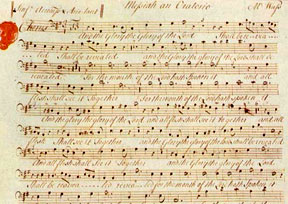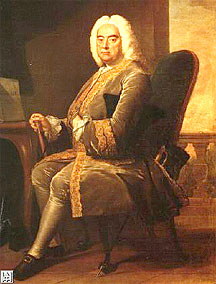Part 2 of series: Handel’s Messiah and Easter
Permalink for this post / Permalink for this series
In my last post I explained why Handel’s Messiah, a piece we ordinary associate with Christmas, is really an oratorio for Easter. Today I want to examine the libretto (the words of the composition) to show the strong Easter themes.
Part I
Part I focuses on the birth and life of Jesus. It begins with prophetic promises of the birth of the Christ, many from the Old Testament book of Isaiah. These include, for example, the Alto recitative: “Behold, a virgin shall conceive, and bear a son, and shall call his name Emmanuel: God with us” (based on Isaiah 7:14). The actual birth of Jesus is revealed, not through the words of Luke 2, but through the prophecy from Isaiah 9:6: “For unto us a child is born . . . .” Then the Messiah narrates the experience of the shepherds outside of Bethlehem, completing the birth story.
The next section of Part I describes the ministry of Jesus as a fulfillment of prophecy, “Then the eyes of the blind be opened. . .” (based on Isaiah 35:5); “He shall feed his flock like a shepherd” (based on Isaiah 40:11). Part I finishes with the invitation of Jesus in Matthew 11:28-29, though this has been rephrased into the third person, “Come unto him all ye that labour” rather than “Come unto me.” The final chorus of Part I celebrates the fact that “His yoke is easy and his burden in light” (based on Matthew 11:30).
 The photo to the right shows a portion of the Messiah in Handel’s own hand. It is the chorus in Part 1 that begins: “And the glory of the Lord shall be revealed.”
The photo to the right shows a portion of the Messiah in Handel’s own hand. It is the chorus in Part 1 that begins: “And the glory of the Lord shall be revealed.”Part II
Part II of the Messiah jumps immediately to the Passion of Jesus: “Behold the Lamb of God, that taketh away the sin of the world” (based on John 1:29). We are prepared for Jesus’s death by Isaiah’s prophecies of the Suffering Servant: “Surely he hath borne our griefs and carried our sorrows” (based on Isaiah 53:4-5). As in the case of Jesus’s birth, his actual death isn’t narrated using texts from the New Testament gospels. Instead, Isaiah 53:8 delivers the news of Jesus’s demise: “He was cut off out of the land of the living, for the transgression of thy people was he stricken.”
Part II delivers the good news of the resurrection in a manner similar to its telling of the birth and death of Jesus. The resurrection isn’t described so much as alluded to through prophetic Scripture, in this case, Psalm 16:10: “But thou didst not leave his soul in hell, nor didst thou suffer thy holy one to see corruption.” (To hear the beginning of this Easter aria, click here [.mov 172K]. To purchase this marvelous recording, click here.]) Following this sweet soprano confession, the whole chorus bursts forth with Psalm 24:7-10: “Lift up your heads, O ye gates, and be ye lift up, ye everlasting doors, and the King of glory shall come in.” Now all of heaven is being summoned to receive the risen Christ into glory.
As Part II draws to a close, the libretto connects the victory of Jesus with the sending out of preachers into the world. Thus the Messiah blends the story of Easter into the story of the Pentecost, just as Eastertide bridges Easter Sunday and Pentecost Sunday. Part II ends most gloriously, with the beloved “Hallelujah Chorus.” Yes, it comes, not in the Christmas section, but in the Passion/Resurrection/Pentecost section. “The kingdom of this world is become the kingdom of our Lord and of his Christ” not in the birth of Jesus, but in his death and resurrection. This will be communicated to the world, so that God “shall reign for ever and ever.”
One could almost accuse the Messiah of indulging a bit too much in realized eschatology here – the belief that the presence of Christ in the church and through the church in the world is equivalent to his second coming. But Part III of the Messiah keeps us from drawing this conclusion.
Tomorrow I’ll finish up this summary by examining Part III and then making some general comments about the Messiah and the deeper meaning of Easter. Stay tuned . . . .

